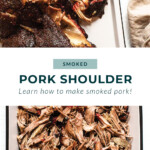The Smoked pork shoulder recipe is first rubbed with a delicious dry rub and then smoked for 7-8 hours. To add flavor, we use an apple juice spritz that’s just out of this world.
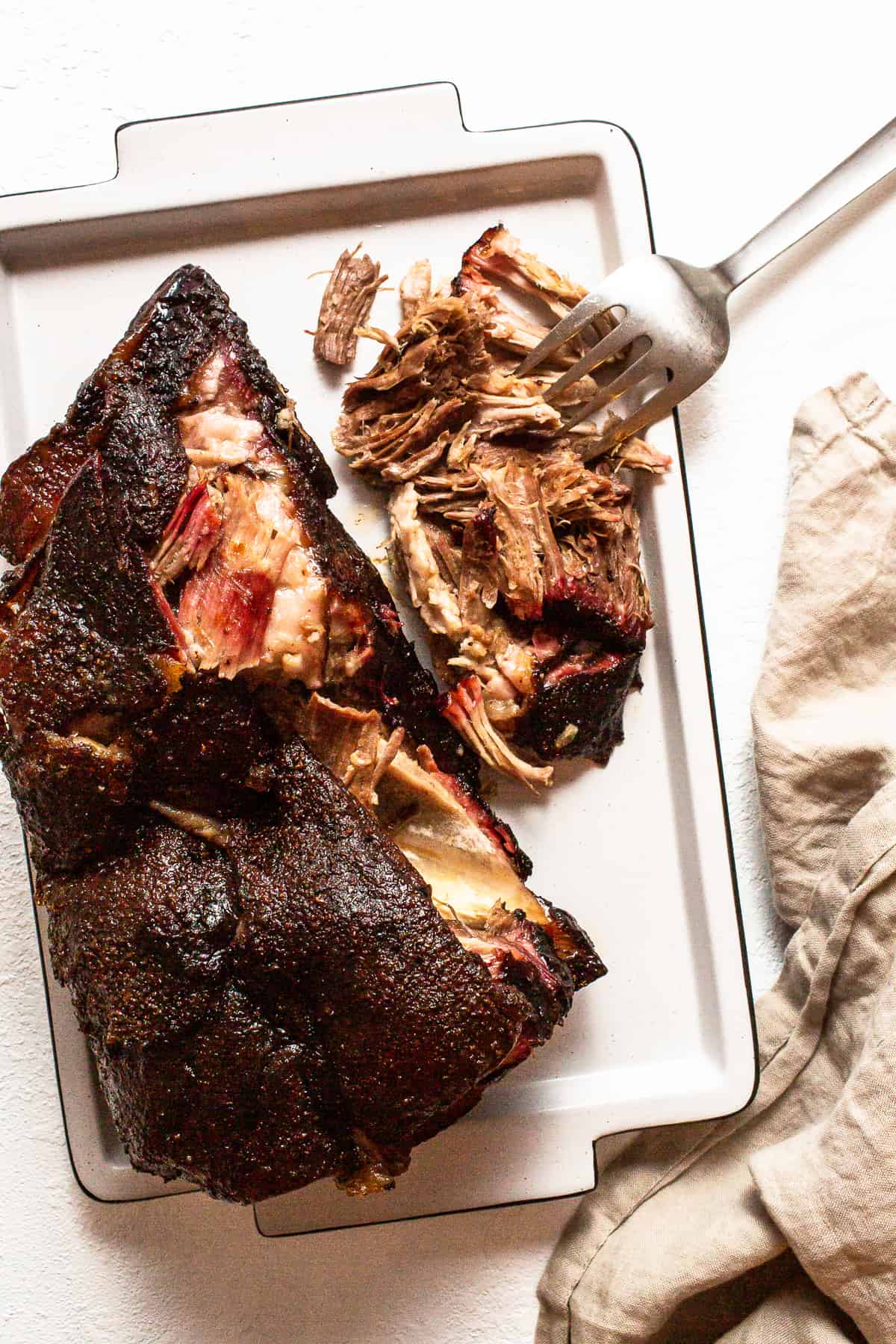
The best smoked pork shoulder
This delicious pork shoulder has a sweet and savory smoky flavor and an unreal tenderness after you let it rest and shred.
We love smoked pork shoulder because it’s cooked low and slow, leaving you with shredded pork that you can use in so many different ways.
We also used a tasty apple juice spritz to add even more flavor during the smoking time!
Tipis for smoked pork shoulder before take off
There are a few things to think about before you start preparing a smoked pork shoulder.
Before doing this, call the meat counter or butcher at your local grocery store to see if they have a 7lb weight. Bone-in Pork Shoulder. They can be hard to come by locally.
Make sure you have enough pellets or wood chips for the smoker. We use a Traeger smoker for smoking recipes and typically use their signature blend for pellets. When using wood chips, the best wood for smoking pork is usually hickory, but cherry or oak add a unique flavor.
Give your smoker or grill time to heat up.
Since you have your smoker on, consider throwing
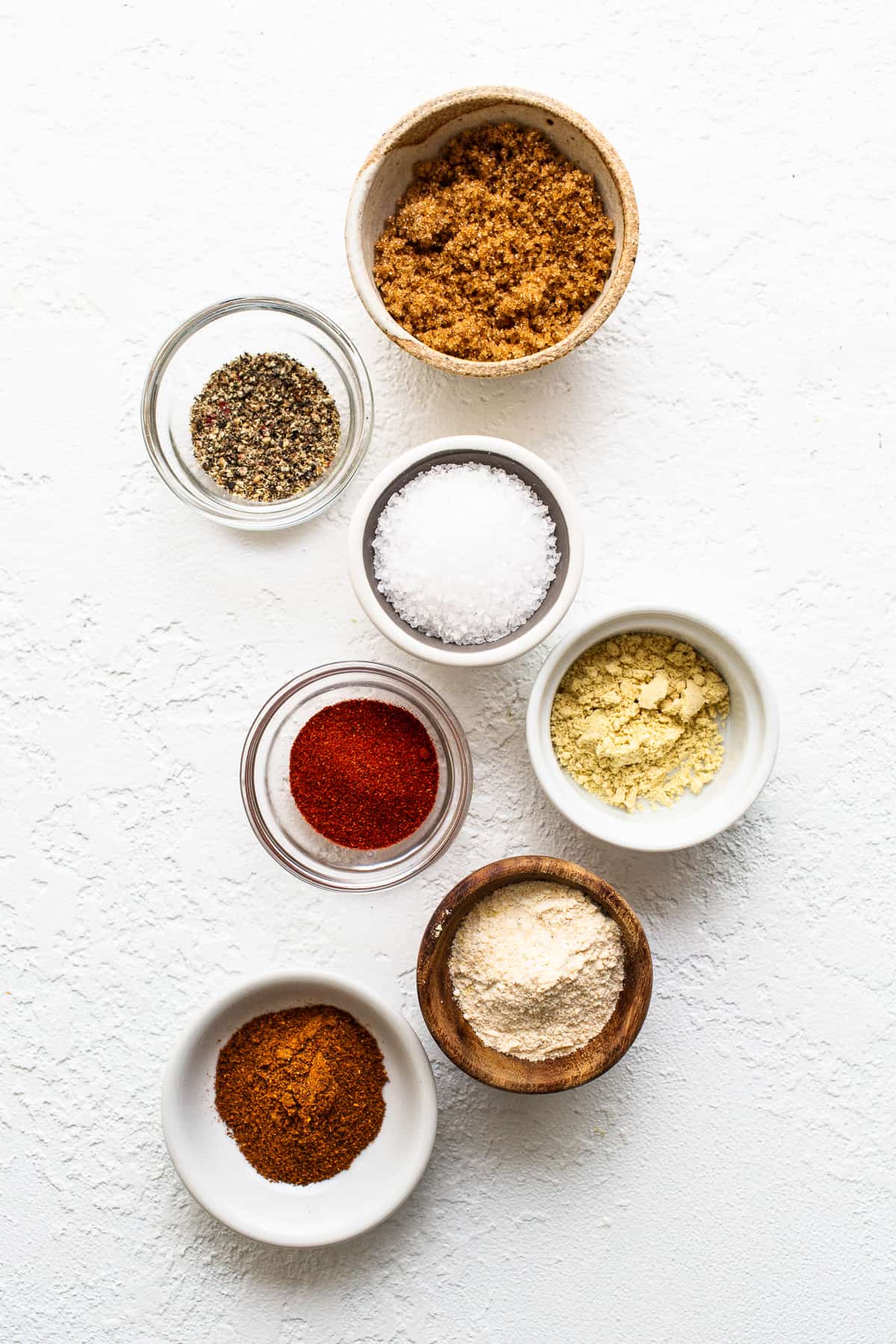
What is pork shoulder?
A pork shoulder comes from a pig’s shoulder. It usually has more fat than a pork loin, making it ideal for slow roasting or smoking.
Both pork shoulder and pork loin can be used for this recipe. Both cuts of meat come from the shoulder. The main difference is that a pork loin has more fat and a pork shoulder has more muscle.
In this pork shoulder recipe, we use a 6-7lb. Bone-in Pork Shoulder.
Other names for pork shoulder
- pork butt
- Picnic Shoulder
- picnic roast
- Boston butt
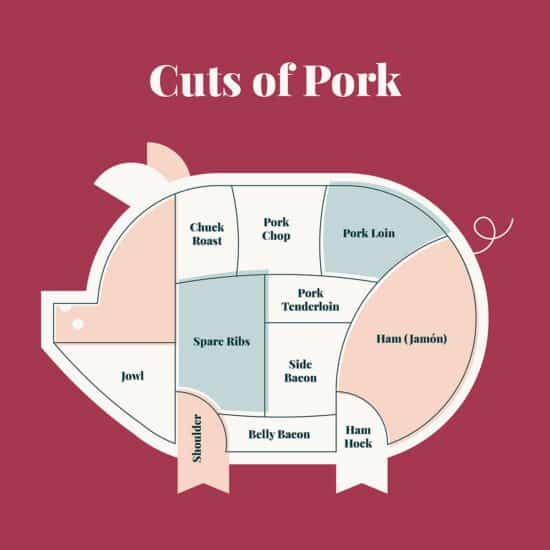
What you need
pork shoulder: This recipe uses a bone-in 7-pound. pork shoulder. We recommend using a bone-in shoulder for smoking as it offers a bit more flavor and fat.
Rub dry: The spices for this smoked pork shoulder are a mix of sweet, savory and salty. Make sure you don’t skimp on the salt. The salt tenderizes the meat and enhances all the delicious flavors of the pork and other dry rub ingredients. Try our Pork Dry Rub!
pellets or wood chips: Although pellets and wood chips are not ingredients, we offer them because the last thing you want to do is run out of extra pellets or wood chips during smoking time.
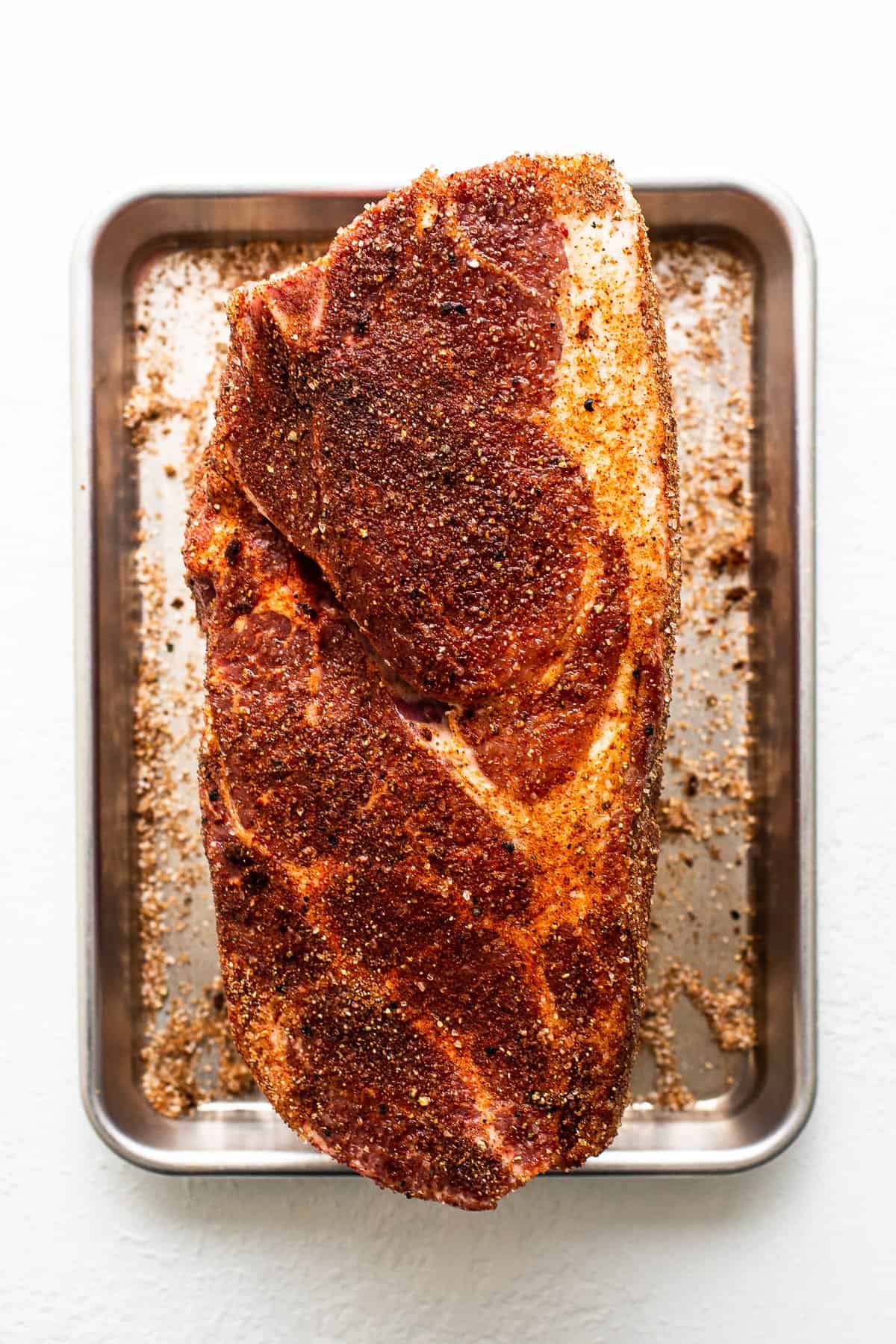
FAQ
A 7 pound pork should take about 7-8 hours in the smoker. The time may vary depending on the size of pork shoulder you are using, what type of smoker you are using, etc. Just be sure to keep an eye on the internal temperature of the pork shoulder.
The internal temperature of pork shoulder is 195-205ºF. Remove the pork from the smoker and let it rest for 20-30 minutes before shredding.
Yes, you can over-smoke a pork shoulder. Be sure to monitor the internal temperature of the pork shoulder to keep the pork from drying out.
Yes, you can freeze smoked pork shoulder. Shred the smoked pork shoulder and let cool. Place the shredded pork shoulder in a freezer safe bag and freeze for up to 3 months.
After shredding or slicing the pork shoulder, you can use the pork in a smoked pulled pork sandwich, wrap, in tacos, on top of nachos, or whatever else you can think of.
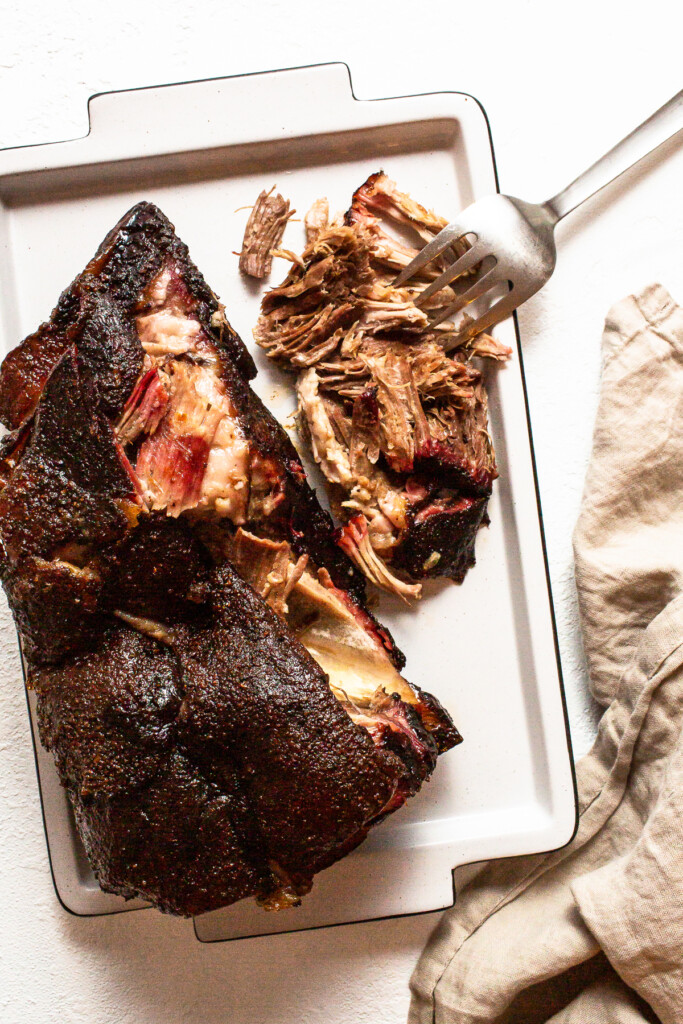
How to make smoked pork shoulder
- Preheat and prepare the smoker. Prepare your pellet smoker, wood chip smoker or charcoal grill. Clean the grates and preheat the smoker to 250ºF.
- Rub the pork shoulder dry. Mix all the dry rub ingredients together and massage the dry rub over the entire pork shoulder. Allow the pork to rest in the dry rub for 30 minutes or more. for extra flavor and tenderness.
- Smoke the pork. Put the pork on the smoker and smoke the pork for 7-8 hours. Prepare the cider spritz and spritz the pork shoulder every hour or two to keep the pork tender and moist.
- Let the pork rest. Once the pork has reached an internal temperature of 190-205ºF, remove the pork from the smoker and let rest for 30 minutes.
- Enjoy. Shred the pork and enjoy at the BBQ or all week long.
Best Tips
Try not to open the smoker too often. If you open the smoker too many times during the smoking process, heat will escape and it will take longer to come up to temperature.
Have extra pellets on hand. Speaking from experience, make sure you check your pellet and chip levels several times during the cooking time. When the pellets run out or the woodchips run out, the temperature drops.

Try it!
Thermoworks thermal pen
We swear by using a meat thermometer when preparing cuts of meat. The Thermapen is our popular meat thermometer that always works.
buy now
Charcoal Grill Instructions
If you don’t have a smoker, you can always smoke this pork shoulder on a charcoal grill.
- Place soaked wood shavings in a foil pan and cover with aluminum foil. Poke holes in the top of the aluminum foil and place the wood chips under the grates of your grill in the back corner.
- Turn the grill up and close the grill.
- When smoke comes out, place the pork shoulder on the grill. Keep adding soaked wood chips to the aluminum pan to keep it smoking. Set the heat on your grill using the temperature gauge.
serving ideas
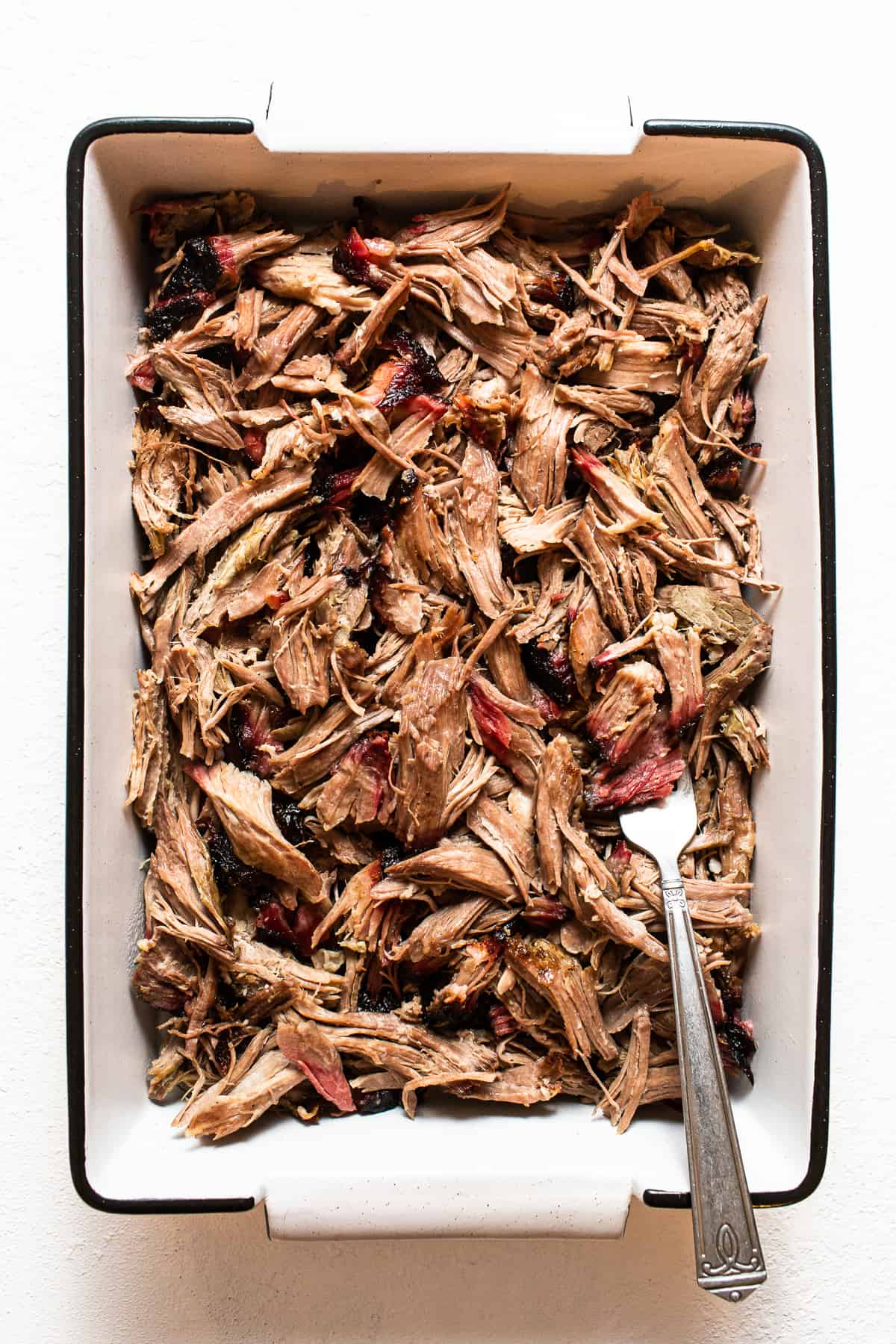
storage
Allow the pork to cool completely before transferring to an airtight container and refrigerating for up to 5-7 days.
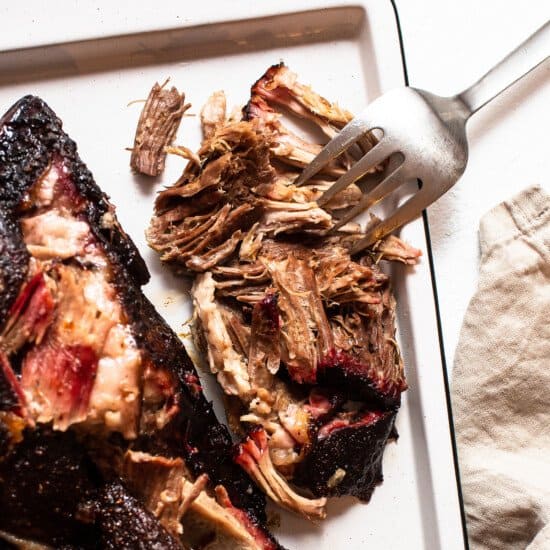
Smoked Pork Shoulder
This smoked pork shoulder recipe is made with a 7-lb. Pork shoulder, a delicious dry rub, and smoked for about 7 hours. It leaves a tender and juicy, delicious smoked pork.
Preparation:2 hours
Cook:8th hours
In total:10 hours
Ingredients
Other
- We used the Signature Traeger Pellets Feel free to use whatever pellets you like.
instructions
-
In a bowl, add salt, brown sugar, garlic powder, paprika powder, chili powder, mustard powder, and black pepper. Blend until combined.
-
Sprinkle half of the dry rub over the pork shoulder and massage the rub into the meat. Turn the pork over and sprinkle the rest of the dry rub over the remaining pork, massaging the dry rub into the meat. Make sure the whole pork shoulder is coated.
-
Wrap the pork shoulder in plastic wrap and refrigerate for at least 2 hours or overnight for best results.
-
Preheat the smoker to 250ºF and place your smoker pellets or smoker chips in the smoker. We used the Signature Traeger Blend Pellets. prepare the apple juice spritz. Pour apple juice, bourbon maple syrup, and apple cider vinegar into a small spray bottle and shake until combined. Put aside.
-
When the smoker is preheated, place the pork shoulder on the smoker and cook for 7-8 hours. Spray the whole pork shoulder with the apple juice spritz every hour or an hour and a half to keep it from drying out.
-
When the pork shoulder has been in the smoker for 6 hours, lower the temperature to 200ºF.
-
When the internal temperature of the pork reaches 195ºF-205ºF, the pork is done.
-
Remove the pork from the smoker and let the meat rest for 20-30 minutes before slicing or shredding.
-
Serve on its own, on tacos, on buns, or in a burrito bowl.
Tips & Hints
- The timing of how long to cook the pork shoulder will vary depending on the smoker and the size of your pork shoulder.
- Feel free to add your favorite seasonings to the dry rub for this pork shoulder.
- You can use any type of pellets or wood shavings you want for this recipe.
- You need about 20 pounds. pellets for this recipe.
nutritional information
Calories: 426kcal Carbohydrates: 6G Protein: 52G Fat: 19G Fiber: 1G Sugar: 5G
Photography: The photos captured in this post are by Ashley McGlaughlin of The Edible Perspective.


